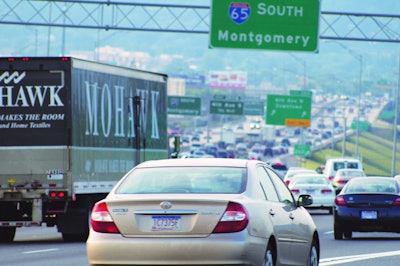 Forcing more trucks into daytime traffic can increase the incidence of non-fatal wrecks.
Forcing more trucks into daytime traffic can increase the incidence of non-fatal wrecks.“There’s something happening here,” goes the old Buffalo Springfield song, “but what it is ain’t exactly clear.” That could easily be said about the recently released annual report on truck accidents.
The Federal Motor Carrier Safety Administration’s report says that the number of trucks involved in fatal accidents decreased 5 percent in 2014, or 6 percent if you count fatalities per miles traveled. The only problem is a conflicting statistic: Injuries in truck-involved wrecks increased by 21 percent. I asked around for explanations.
There’s no discrepancy between the two points, says FMCSA Spokesman Duane DeBruyne. He noted that new technologies “such as electronic stability control, automatic emergency braking, forward collision warning, lane departure … are saving lives by making many more crashes ‘survivable’ that previously were not.”
Wayne State University’s Michael Belzer, author of the trucking compensation classic “Sweatshops on Wheels,” notes that “there is a substantial amount of randomness in all crash data, but especially when the number is small, like fatalities.” Being a larger base number and showing a larger amount of change, injury data “might allow one to infer more reliably that truck-related safety is declining,” he says, but further research would be needed to prove that.
Dan Murray, vice president of the American Transportation Research Institute, did not hesitate to identify the something that’s happening here. He referred to ATRI’s July 2013 report, “Assessing the Impacts of the 34-Hour Restart Provisions.” It went to great lengths in its attempt to debunk FMCSA’s justifications for its restart regulations that had then just taken effect: requiring that the restart include two 1-5 a.m. periods and limiting use to once per week.
“We predicted and documented that when you move trucks into the daytime, basically rush hours, property damage crashes go way up, injury crashes go way up,” Murray says. “Because trucks were moving at 6 miles per hour instead of 55 miles per hour, fatals went way down.”
He concludes that injuries jumped in 2014 because that was the first full year that included the new restart provisions. Other possible factors were the continued shortening of average length of haul, Murray says, and growing congestion.
Truck-involved injuries, like truck-involved fatalities, have declined strongly when averaged over many years. Both took even bigger dips during the recession, rose as post-recession traffic rebounded, then began to level off. However, wrecks with injuries experienced a notable decline in 2013, followed by the 21 percent reversal in 2014.
I’d say the restart regs are the most identifiable 2014-specific factor to blame. If so, it illustrates how easily a problem can worsen when bureaucrats force their contrived and narrow solutions on millions of drivers in highly diverse operations.










